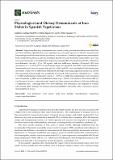Por favor, use este identificador para citar o enlazar a este item:
http://hdl.handle.net/10261/188959COMPARTIR / EXPORTAR:
 SHARE SHARE
 CORE
BASE CORE
BASE
|
|
| Visualizar otros formatos: MARC | Dublin Core | RDF | ORE | MODS | METS | DIDL | DATACITE | |

| Título: | Physiological and dietary determinants of iron status in spanish vegetarians |
Autor: | Gallego-Narbón, Angélica CSIC ORCID; Zapatera, Belén CSIC ORCID ; Vaquero, M. Pilar CSIC ORCID | Palabras clave: | Iron deficiency Iron status Body iron Ferritin Menstruation Vegetarian Vegan Supplementation |
Fecha de publicación: | 26-jul-2019 | Editor: | Multidisciplinary Digital Publishing Institute | Citación: | Nutrients 11(8): 1734 (2019) | Resumen: | Vegetarian diets may compromise iron status, as they provide non-haem iron which has low bioavailability. Spanish lacto-ovo vegetarians (n = 49) and vegans (n = 55) were recruited and haematological and biochemical iron parameters were analysed. Food and supplements consumption, body composition, physical activity, menstrual blood losses and hormonal contraceptive use were assessed. Four groups were studied: Iron deficiency anaemia (IDA), iron depletion (ferritin <15 ng/mL), iron deficiency (ferritin ≥15 to ≤30 ng/mL), and iron sufficiency (ferritin >30 ng/mL). IDA was uncommon (n = 5, 4.8%), 27.9% of participants were iron-depleted, and 30.8% were iron-deficient. Serum ferritin was lower in women than men (p < 0.001) and IDA and iron depleted individuals were all women. There were no differences attributed to diet type, time being vegetarian or physical activity. The menstrual period length was negatively associated with transferrin saturation (ρ = −0.364, p = 0.001) and hormonal contraceptive use (ρ = −0.276, p = 0.014). Iron supplements were consumed most frequently by IDA and iron-deficient subjects (p = 0.031). Conclusions: Iron status did not vary between lacto-ovo vegetarians and vegans and there was not an influence of the time following a vegetarian diet. Although men were iron-sufficient, iron deficiency was frequent in women, who should apply strategies to increase iron bioavailability, especially if they experience intense menstrual blood losses. | Descripción: | © The Author(s). | Versión del editor: | https://doi.org/10.3390/nu11081734 | URI: | http://hdl.handle.net/10261/188959 | DOI: | 10.3390/nu11081734 | ISSN: | 2072-6643 | E-ISSN: | 2072-6643 |
| Aparece en las colecciones: | (ICTAN) Artículos |
Ficheros en este ítem:
| Fichero | Descripción | Tamaño | Formato | |
|---|---|---|---|---|
| Physiological_Gallego_Narbon_Art2019.pdf | 272,74 kB | Adobe PDF |  Visualizar/Abrir |
CORE Recommender
PubMed Central
Citations
8
checked on 21-abr-2024
SCOPUSTM
Citations
15
checked on 11-may-2024
WEB OF SCIENCETM
Citations
14
checked on 26-feb-2024
Page view(s)
250
checked on 13-may-2024
Download(s)
218
checked on 13-may-2024

